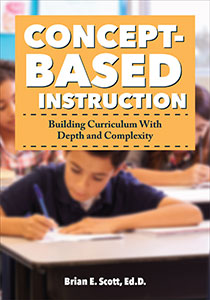Concept Mapping Across the Curriculum
Concept-Based Instruction: Building Curriculum with Depth and Complexity
By Brian E. Scott, Ed.D.
(Prufrock Press, 2020 – Learn more)
Reviewed by Mary K. Marsh
This spring, wanting to focus on something other than the uncertainties of school during a pandemic, I began re-thinking how to approach my middle school social studies class by themes and break away from the chronological pull of history instruction. Well-aware of the traps of textbooks and timelines, I was excited to read Brian E. Scott’s Concept-Based Instruction: Building Curriculum with Depth and Complexity.

Centering on curriculum mapping
Key to developing a concept-based unit is a detailed and complete curriculum mapping of all subject areas in the grade level. Scott explains and illustrates how to complete this process, but teachers whose districts have already done curriculum mapping will have a huge advantage.
This process is a meaningful way to use all that mapping information! High-quality curriculum maps (NOT just your standards) provide the bird’s eye view that will allow teachers to find common, broad-based themes and cross curricular connections.
Gifted students and self-contained classes
The information in this book will be of greatest value to teachers with gifted and/or self-contained classrooms. In fact, teachers returning to in-person instruction who are now newly self-contained might find this approach an opportunity to re-engage students and create a reassuring learning environment.
Scott’s curriculum strategies could also be a successful, highly cohesive approach for middle school teams. Teachers like myself, who teach a single subject, can still use this approach to examine content and standards, re-orient them, and then create deeper dives into their curriculum.
For those who find tables and charts helpful, this book frequently employs them to organize and illustrate its ideas. The tables and charts included within the chapters are well-detailed and follow the development of the ideas presented in the book. The appendix includes blank planning templates.
However, a formatting issue that became distracting was the frequent awkward placement of tables within the text. For example, page 28 ends with, “The 10 themes are:..” but the text doesn’t pick up again with the actual list until page 43. Then after that single page of text (ending in an actual word break this time) another table placement displaces the text until page 53. While I’m sure this disruption was unintended, it did become annoying for me personally.
Bringing it all together
Concept-Based Instruction includes clear explanations of several key instructional frameworks that every teacher should know and incorporate in their classroom. And Scott refers to how these critical ideas support the process of developing concept-based units throughout the book. He emphasizes that all these approaches need to be combined as teachers create concept-based units of study.
I’d strongly recommend that teachers who are not familiar with Webb’s depth of knowledge, Tomlinson’s differentiated instruction, Marzano’s instructional strategies, or Wiggins and McTighe’s essential questions, start with discovering those approaches first. This book does not provide examples of completely designed units or classroom vignettes. The sample unit provided is a detailed chart. The how-to of implementing the concept-based unit is left to the teacher’s expertise.
Reading Concept-Based Instruction will help teachers realize how to use curriculum mapping to identify thematic trends and then pull that information together for effective cross-curricular planning. Once teachers have a clear understanding of how the individual strands of their curriculum can connect under a theme, using high-value teaching practices will bring rigor, engagement and transferability for deeper understanding.
This is a big challenge, especially during the current educational environment, but Concept-Based Instruction gives a helpful blueprint when the time is right.
Mary K. Marsh has been teaching as a reading specialist and social studies teacher for 12 years and is currently teaching 7th grade social studies in Bellbrook, Ohio. She enjoys reading, binge watching quirky comedies, and spending time with her all-grown-up children.


































